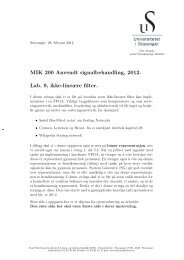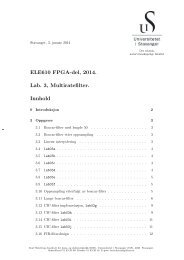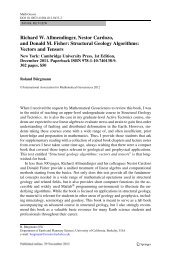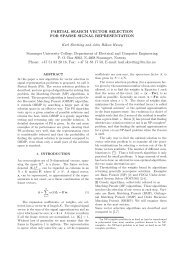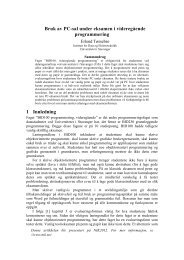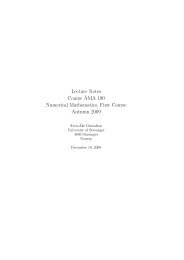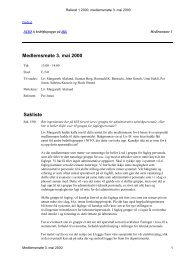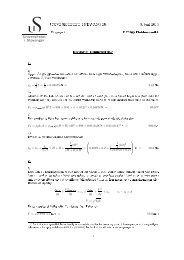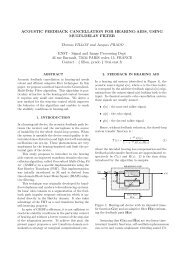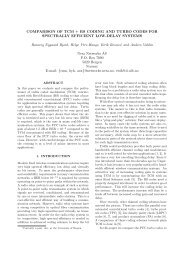Design of linear-phase FIR filters with minimum ... - ResearchGate
Design of linear-phase FIR filters with minimum ... - ResearchGate
Design of linear-phase FIR filters with minimum ... - ResearchGate
Create successful ePaper yourself
Turn your PDF publications into a flip-book with our unique Google optimized e-Paper software.
ĥ( lb)mmin( 1,h( lb )m s ( ub)) h ( lb) ⎧, m ≥ 0= ⎨max( – 1,h ( lb )m s ( lb)),h ( lb) ⎩m < 0(18)If the passband gain is specified we have s (ub) = s (lb) = s s ,where s s is the specified passband gain. Finally, the followinginequality is obtainedĥ ( lb ) m ≤ h ≤ ĥ ( ub )m m(19)This inequality can either be added to the constraints <strong>of</strong>the optimization or used to preevaluate possible values <strong>of</strong>the variables. Here, (19) is utilized to determine which bitsthat do have a fixed value and remove these from the optimizationproblem. This can be done by searching all possiblevalues for the filter coefficient and keep track <strong>of</strong>which values the bits assume. All variables that only assignone value can be fixed and thereby removed from theoptimization problem.As will be shown in the example below, the number <strong>of</strong>variables that can be removed depends on the availabledesign margin and the representation used. The number <strong>of</strong>variables that can be removed are in general not dependenton the coefficient wordlength, as typically it is the mostsignificant bits <strong>of</strong> a coefficient that are fixed. However,the relative savings will be smaller when the wordlengthis increased.5. EXAMPLETo show the usefulness <strong>of</strong> the proposed idea we will considerone filter design example. The filter under considerationis a lowpass filter <strong>with</strong> passband edge at 0.3π andstopband edge at 0.5π. The allowed ripple is 0.001 in boththe passband and the stopband. A filter order <strong>of</strong> 33 is used.Hence, there are 17 coefficients to be designed. Using theRemez exchange algorithm and rounding, 15 coefficientbits are required to satisfy the specification. For two’scomplement representation the sum <strong>of</strong> the Hamming distancesbetween subsequent coefficients are 118. Using theproposed design method a solution <strong>with</strong> 13 bits can befound <strong>with</strong> a total Hamming distance <strong>of</strong> 79. The originaloptimization problem has 448 variables, while after theproposed preprocessing it has 292 variables. Thus, a significantspeed-up was obtained for the solution. The problemwas solved on an AMD Athlon 1800+ <strong>with</strong> 1.5 GB <strong>of</strong>RAM. The pre-processing took approximately 30 s, whilethe MILP stage took 55 minutes. For signed magnituderepresentation, the rounded solution has a total Hammingdistance <strong>of</strong> 78. The original optimization problem has 652variables, while after preprocessing 255 variables remain.The optimized solution has a total Hamming distance <strong>of</strong>60. For this problem the MILP stage took approximately150 minutes. The magnitude responses for the three designed<strong>filters</strong> are shown in Fig. 2.|H(e jωT )| [dB]0−10−20−30−40−50−60−70−800 0.2π 0.4π 0.6π 0.8π πωT [rad]Figure 2: Magnitude responses for example filterdesigned using (solid) Remez and rounding,(dashed) proposed approach <strong>with</strong>two’s complement representation, and(dotted) proposed approach <strong>with</strong> signedmagnitude representation.6. CONCLUSIONSIn this paper a mixed integer <strong>linear</strong> programming problemfor design <strong>of</strong> <strong>linear</strong>-<strong>phase</strong> <strong>FIR</strong> <strong>filters</strong> <strong>with</strong> <strong>minimum</strong> Hammingdistance between adjacent coefficients was formulated.It has been shown in earlier work that the Hammingdistance is a good measure <strong>of</strong> the power consumption fora programmable <strong>FIR</strong> filter. A preprocessing technique toremove 0/1-variables, and, thus, decrease the solutiontime, was discussed. Both two’s complement and signedmagnitude representation were considered. A design exampleshowed the usefulness <strong>of</strong> the proposed method.7. REFERENCES[1] T. Saramäki and J. Yli-Kaakinen, “<strong>Design</strong> <strong>of</strong> digital <strong>filters</strong>and filter banks by optimization: applications,” in Proc. XEuropean Signal Processing Conf., Tampere, Finland,Sept. 4–8, 2000.[2] H. Samuli, “An improved search algorithm for the design<strong>of</strong> multiplierless <strong>FIR</strong> <strong>filters</strong> <strong>with</strong> powers-<strong>of</strong>-two coefficients,”IEEE Trans. Circuits Syst., vol. 36, pp. 1044–1047, July 1989.[3] O. Gustafsson, H. Johansson, and L. Wanhammar, “AnMILP approach for the design <strong>of</strong> <strong>linear</strong>-<strong>phase</strong> <strong>FIR</strong> <strong>filters</strong><strong>with</strong> <strong>minimum</strong> number <strong>of</strong> signed-power-<strong>of</strong>-two terms”, inProc. European Conf. Circuit Theory <strong>Design</strong>, Espoo, Finland,Aug. 28–31, 2001.[4] M. Mehendale, S. D. Sherlekar, and G. Venkatesh, “Coefficientoptimization for low power realization <strong>of</strong> <strong>FIR</strong> <strong>filters</strong>,”in Proc. IEEE Workshop VLSI Signal Processing,1995, pp. 352–361.[5] P. K. Merakos et al, “A novel transformation for reduction<strong>of</strong> switching activity in <strong>FIR</strong> <strong>filters</strong> implementation,” inProc. Int. Conf. Digital Signal Processing, 1997, vol. 2,pp. 653–656.[6] ILOG, http://www.ilog.com/, June 2002.[7] Y. C. Lim, “<strong>Design</strong> <strong>of</strong> discrete-coefficient-value <strong>linear</strong><strong>phase</strong> <strong>FIR</strong> <strong>filters</strong> <strong>with</strong> optimum normalized peak ripplemagnitude,” IEEE Trans. Circuits Syst., vol. 37, pp.1480–1486, Dec. 1990.



